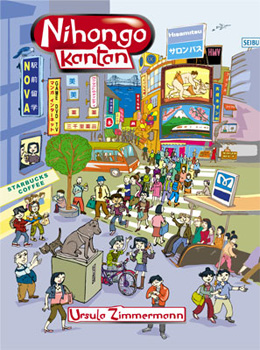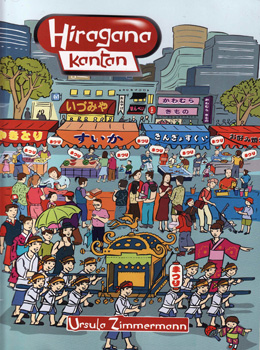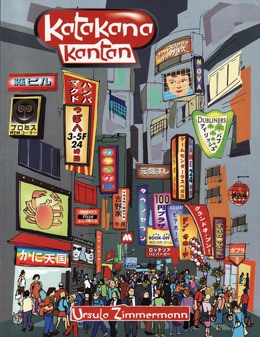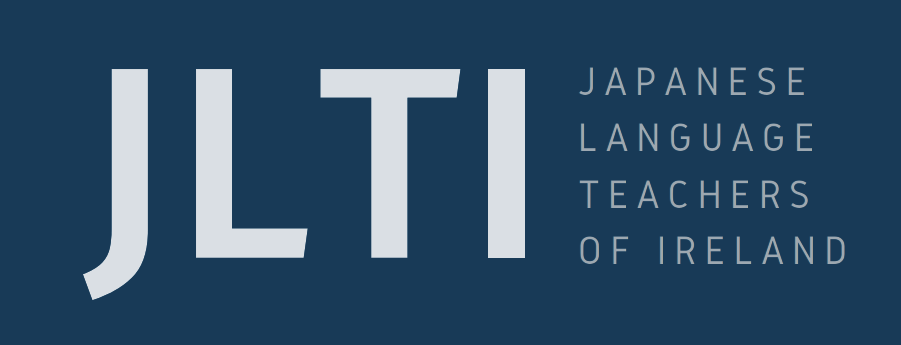Studying Japanese
This page contains information about study materials developed in Ireland, and those on Japanese examinations and essay contest.
Nihongo Kantan
By Ursula Zimmermann (The Department of Education and Science 2007)

Nihongo Kantan is an original teaching resource developed in Ireland and covering the Japanese syllabus for the Leaving Certificate, the terminal examination in the Irish post-primary education system. As a result, the conversations and scenarios are intended for post-primary level learners, but the book’s content, aimed at beginners in Japanese, will be useful to a wide range of learners such as university students and adults. The target level is level 4 in the Japanese Language Proficiency Test or near the Common European Framework of Reference A2 level.
The book comprises 12 units in 300 pages and each unit is structured according to topic. At the end of each unit there is a lively “Culture Corner” which gives plenty of information about today’s Japan using a wealth of photos and full-colour illustrations. The book also introduces the 100 kanji prescribed for the Leaving Certificate through the “Kanji Corner” feature, where kanji are grouped according to topic and practised using the correct stroke order. In addition the “Grammar Check” and “Word Check” features give a convenient and easy to use summary of grammar and vocabulary items in each unit. There are well-thought out practice activities to develop the four skills of listening, speaking, reading and writing in a balanced manner, and the clear and detailed explanations of grammar points in English make the book suitable for self-study.
Two CDs are included to further develop listening skills, and used in conjunction with the companion texts “Katakana Kantan” and “Hiragana Kanan” for learning kana, the materials promise a very effective means of studying Japanese.
See also an article in the Irish Independent on “Nihongo Kantan”.
Hiragana Kantan
By Ursula Zimmermann (The Department of Education and Science, 2005)

This was the second teaching resource in Japanese developed for the terminal examination in the Irish post-primary system, the Leaving Certificate. Comprising 64 pages and 5 units, it introduces hiragana not in the usual order used in Japan but using material needed for self introductions and the like.
The book presents the various fonts used in printing hiragana, and through various practice activities, including listening activities, it is possible to use it to learn hiragana efficiently.
There is space given over in this book also for the writing of hiragana using correct stroke order and a CD is included, so the materials are suitable for independent study.
Since all three books in the series Katakana Kantan, Hiragana Kantan and Nihongo Kantan have related content, learning is most effective if they are used together.
Katakana Kantan
By Ursula Zimmermann (Institiúid Teangeolaíochta Éireann, 2003)

This was the first teaching resource in Japanese developed for the terminal examination in the Irish post-primary system, the Leaving Certificate. With 56 pages in all, it takes the unique approach of introducing katakana using world place names. For example, the first unit introduces the characters for “Ireland” while unit 2 introduces those for the “United Kingdom” and unit 3 uses the characters used in “Uganda”.
Through enjoyable activities like matching games and crossword, those using the book can learn place names, people’s names sports and other vocabulary items.
On the first page of each unit there is a space for practicing the writing of the characters to be introduced in the correct stroke order so the book is suitable for independent study.
The materials are put together to ensure that katakana can be learned efficiently and quickly.
“Interactive Multimedia Courseware for Reading and Writing Japanese Script”
Project Coordinator: Barbara Geraghty, Japanese Section, Department of Languages and Cultural Studies, University of Limerick
This courseware CD was developed by Barbara Geraghty, one of the founding members of the JLTI, and her team at the Japanese Section of the Department of Languages and Cultural Studies at the University of Limerick.
Using a colour-based method, and integrating sound files and animation demonstrating the stroke order, this Flash-based software was designed for teaching the reading and writing of Hiragana. This project was awarded the European Award for Languages in 2007. (See here).
Japanese Language Examinations
THE JAPANESE LANGUAGE PROFICIENCY TEST (JLPT) This exam is held annually on the first Sunday of December, and can take in London, Paris, etc.
In December 2009, this test was held in Ireland for the first time. For further information on the JLPT in Ireland, please check this web site.
Additional reference information may be found at the School of Oriental & African Studies (SOAS), University of London. Please check this site.
